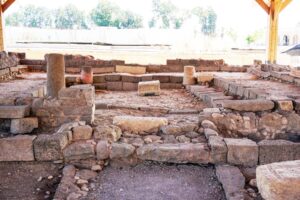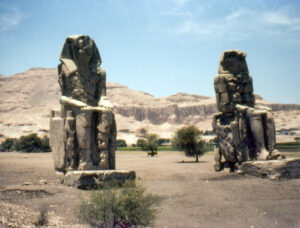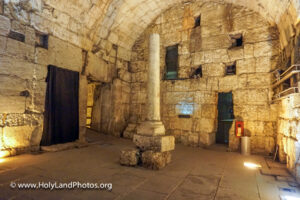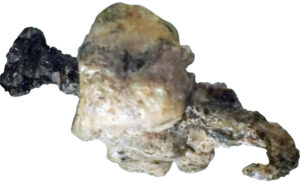By Dr. Don Bierle, FaithSearch President
Here is a quick rundown of some recent and notable discoveries, as announced in established journals.
Second Synagogue Found in First Century Magdala
People in the U.S. are accustomed to seeing several churches located in the same city, sometimes only a block apart. It is not so much the case with synagogues. Only a few synagogues have ever been found in the whole of the Galilee, much less two in the same community.

Magdala is located on the northwestern shore of the Sea of Galilee and is thought to be the birthplace of Mary Magdalene and the main base of operations for the Jewish historian Josephus when he was a rebel leader during the First Jewish Revolt (A.D. 66-70). A more elaborate synagogue was found there in 2009, complete with ritual baths and colorful frescoes. This second one, announced in December by the University of Haifa, was a simple square-shaped building with a central hall and two small rooms. It is thought that their differences may be location in the city. The first was located in a commercial area, while the more recent one was found in a residential neighborhood.
Jesus often visited Jewish synagogues during His ministry and was usually invited to speak (Luke 4:16). It was here that He often introduced His redemptive message (vv. 17-21).
An Unknown Egyptian City

Egyptian archaeologists announced the discovery of a 3,000-year-old and previously unknown city, named Aten, on the west bank of the Nile River near Luxor. Aten, believed to be the largest Egyptian city ever unearthed, dates to the reign of Pharaoh Amenhotep III. This pharaoh was the grandson of Amenhotep II, who is believed by some evangelical scholars to be the pharaoh of the Exodus.
The city appears to have been suddenly abandoned. So far, the dig revealed valuable artifacts like jewelry, colored pottery – and to the team’s great surprise – formations of mud bricks appeared everywhere. It is expected that additional excavation will reveal many details of daily life in Egypt around the time of Moses.
More Dead Sea Discoveries
The Israel Antiquities Authority announced the results of a four-year excavation project in hard-to-reach caves overlooking the Dead Sea. Finds included arrowheads, coins, combs, the mummified remains of a young girl, and dozens of scraps of biblical texts. The scroll fragments, containing passages from Zechariah and Nahum, are unrelated to the texts produced by the Qumran community, known as the Dead Sea Scrolls. They nonetheless shed light on the long work of translating and transcribing Scripture.
For archaeologists, the most amazing discovery was an ancient basket, complete with intact lid, and thought to be the oldest intact basket in existence. It is reminiscent of other biblical baskets, such as the one that held the baby Moses in Exodus (Exodus 2:3), the ones that carried the leftovers when Christ fed the multitudes in the Gospels (John 6:13), and the one that helped the apostle Paul escape persecution, when he was lowered over the wall of Damascus (Acts 9:25).
Herod the Great’s Green Thumb
King Herod, when he was not building something, evidently had a gardening hobby (or employed someone who did). Soil samples from excavations at his Jericho palace, taken almost a half century ago, were recently analyzed, and the pollen particles revealed sophisticated horticulture. Miniature pine, cypress, cedar, and olive trees were grown in clay pots. Many of the tree species would not typically have grown in the desert around Jericho, making the garden a demonstration of Herod’s greatness, a horticultural feat meant to impress guests and subjects alike.
A Temple Mount Banquet Hall

(Image courtesy: holylandphotos.org)
A luxurious public building located next to the Temple Mount has been excavated and opened to public tours. Part of the building was first discovered by British archaeologist Charles Warren in 1867, and the site was partially excavated in 1966. Now the excavation is complete and archaeologists have dated its original construction to A.D. 20—during the lifetime of Jesus.
The building contained two identical chambers, separated by an elaborate fountain. The luxurious nature of the facility and its adjacency to the Temple Mount indicates it was probably used by the elite members of the first-century Jewish community, the families of the high priests, and other leading religious figures.
Archaeologists say it was damaged by an earthquake in A.D. 33, then later rebuilt and reconfigured into three vaulted halls. Could the destruction be evidence of the earthquake recorded in the Gospel accounts at the crucifixion of Jesus (Matthew 27:51, 54)?
A Crucifixion Foot

(This model of the original [which has since been re-interred] is displayed in Jerusalem.) (Photo courtesy: Adrian Van Vactor)
The Roman practice of crucifixion is well known from ancient sources, including the Gospel accounts of Jesus’ death. Until 2021, the only direct archaeological evidence of crucifixion was a man found in a burial cave in Israel in 1986, with a nail through his foot. [Pictured and discussed in my book Surprised by Faith, p. 50.] In early December 2021, it was announced that a skeleton had been excavated from a grave at Fenstanton in Cambridgeshire, England. The remains had a nail driven through the right foot. The burial dates to around A.D. 400, during the Roman occupation of England.
Sources: Christianity Today News, Gordon Govier, December 21, 2021. Biblical Archaeology Review, Summer 2022, p. 10.



